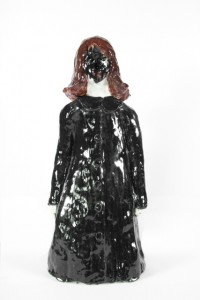Body and Soul: New International Ceramics
by Mary Bucci McCoy
Museum of Arts and Design (MAD)
New York, NY
Through March 2, 2014
Independent curator Wendy Tarlow Kaplan has had a dedicated career in the fine arts in Boston, with positions at the Museum of Fine Arts, the former Fogg Art Museum, Harvard University, as curator for the Art Complex Museum in Duxbury, and the Women’s Studies Research Center at Brandeis. In the case of her latest curated exhibition, she has brought together diverse ceramic work from 24 artists in an international exhibition in New York. She examines contemporary figurative clay sculpture as a vehicle for social commentary, with topics including violence, identity, sexuality, and oppression. Nearly half of the artists are French; the remainder are from the United States, the United Kingdom and Scandinavia.
As a sculptural material clay is versatile: its possibilities include hand building, molds, fashioning on the potter’s wheel; carving; and extrusion. Some techniques allow for a physically intimate dialogue between maker and material as the piece is formed. Others require meticulous planning and execution. The artists—some of whom work in multiple media, or came to ceramics from other media—draw on a broad range of both traditional artisanal techniques as well as industrial methods. All of the work, whether addressing societal issues on a personal or political level, at its core addresses human fragility. In the service of this message, each maker leverages technique and materials to communicate a broad spectrum of emotional, intellectual, and physical nuance.
French artist Damien Cabanes as well as Swedish artist Klara Kristalova make raw, hand-modeled female figures that communicate with a direct, emotional immediacy echoing the directness of the work’s facture. Hand-built figures by Kim Simonsson, a Finnish artist, are more refined; he is influenced by Japanese manga and his all-white figures have a surreal, cartoon-like feel to them. His Untitled greets the visitor at the exhibition’s entrance with an ensemble of three children, two of whom are being terrorized by the third, who holds a gun behind her back.
 Hallow, 2009. Klara Kristalova. Glazed Stoneware. The Speyer Family Collection, New York.
Hallow, 2009. Klara Kristalova. Glazed Stoneware. The Speyer Family Collection, New York.
Paris-based Moroccan artist Mounir Fatmi is concerned with the intersection of labor issues and race in Forget, an arrangement of black skulls wearing white hard hats. We read the cast porcelain pieces through the lens of what we know about hard hats: they are thermal plastic, so our reading of the perfectly glossy white hardhat extends to the similarly glossy black skull as composed of plastic. Yet this piece is ceramic in its entirety, the intrinsic fragility of the material subverting the hardhat’s protective purpose. There are ten skulls contained in Forget, but these cast forms could be mass-produced, and that possibility of replication deepens Fatmi’s message.

Forget, 2010. Mounir Fatmi. Porcelain. Courtesy of the artist; Goodman Gallery, Johannesburg, Cape Town
American artist Kate McDowell updates the myth of Daphne to address environmental concerns with her crisply detailed, ghostly porcelain installation. The Daphne/tree has been chopped down, her head lying next to the feet/tree stump, surrounded by painfully sharp porcelain shavings and leaves in a scene of grim aftermath. The work looks cast, but is in fact hand built, a technical tour de force. American artist Chris Antemann in collaboration with Kendrick Moholt co-opts the trope of the traditional porcelain figurine; staging elaborately detailed multi-figure scenarios such as Feast of Impropriety, a conflated confection of genteel china-painting techniques and nude or nearly nude diners who are anything but genteel.
 Daphne, 2007. Kate MacDowell. Hand built porcelain. Collection of Karen Zukowski and David Diamond. Photo Credit: Dan Kyitka
Daphne, 2007. Kate MacDowell. Hand built porcelain. Collection of Karen Zukowski and David Diamond. Photo Credit: Dan Kyitka
The exhibition is bookended at one extreme by French artist Valérie Delarue’s video Corps au Travail (Body of Work) in which, nude, she physically confronts the raw clay walls of the room that encloses her, and on the other by British artist Jessica Harrison’s appropriated and gruesomely altered mass-produced ceramic figurines. Their female names—Andrea, Amanda, and Karen, for example—only heighten the effect of their holding severed or extracted body parts in a feminist examination of the duality of female interiority/exteriority.
Considering the constraints of the gallery, Body and Soul is well installed. While the space is beautiful, the two permanently installed long L-shaped cases that contain most of the works in the exhibition emphasize their identity as precious, fragile objects, skewing a reading towards craft. This setup also denies the curator freedom in establishing sight lines and relationships and thus limits multiple dialogues between artworks. It forces the viewer to connect much of the work in a largely linear fashion. It also makes it difficult to access a full 360-degree view of the work. A more flexible gallery space might have allowed for a richer installation and permitted the viewer a more free-ranging encounter with the works. Regardless, the exhibition is a significant contribution to the ongoing discussion of figurative art’s continuing relevance. As Body and Soul demonstrates, clay brings a particular resonance to this classical, here politically inflected, timely content.
Originally trained in ceramic sculpture in the United States and Switzerland, Mary Bucci McCoy is a painter based in Beverly, MA. Her next solo exhibition will be in April 2014 at Kingston Gallery in Boston. Mary also writes regularly for Art New England.
